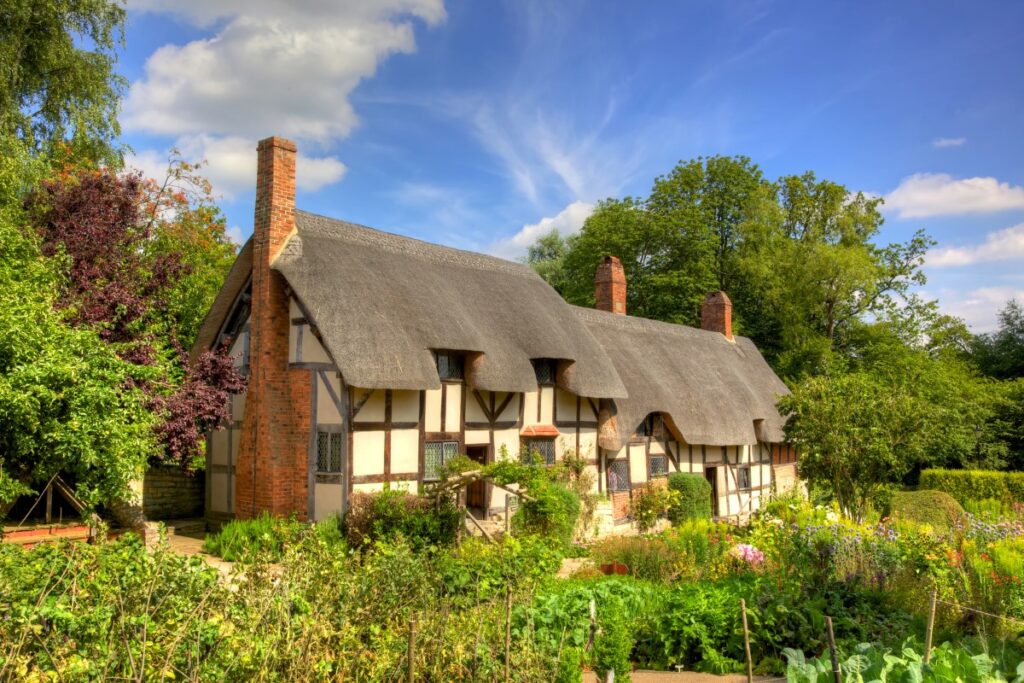10 facts about houses throughout history in England, focusing on their construction methods, materials, and costs:
- Thatched Roofs in Medieval Times: During the medieval period, many houses in England featured thatched roofs. Thatch, made from straw or reeds, was a common roofing material due to its abundance and insulating properties. Thatched roofs were often steeply pitched to shed rainwater effectively.
- Tudor Half-Timbered Houses: In the Tudor period (late 15th to early 17th century), half-timbered houses became popular. These houses had exposed wooden frames filled with wattle and daub. The upper stories often projected over the lower ones, creating a distinctive overhanging appearance.
- Georgian Symmetry: In the Georgian era (1714-1837), houses were characterized by symmetry and classical proportions. The use of brick became more common, and sash windows with multiple panes became a popular architectural feature.
- Victorian Terraced Houses: During the Victorian era (1837-1901), the Industrial Revolution influenced housing construction. Terraced houses, often made of brick, became prevalent in urban areas. The Victorian terrace featured intricate brickwork, bay windows, and decorative ironwork.
- Arts and Crafts Movement: In the late 19th and early 20th centuries, the Arts and Crafts movement led to a revival of craftsmanship in house construction. The movement emphasized traditional materials like wood and stone, rejecting mass production in favor of handmade details.
- Edwardian Elegance: The Edwardian period (1901-1910) marked a shift towards simpler designs. Edwardian houses were often larger than their Victorian counterparts, featuring spacious rooms, high ceilings, and large windows.
- Post-War Prefabricated Homes: After World War II, there was a shortage of housing in England. To address this, the government introduced prefabricated homes, known as “prefabs.” These houses were quickly assembled from factory-made components to provide temporary accommodation.
- 1960s Modernist Architecture: In the 1960s, Modernist architecture gained popularity. Houses from this era often featured flat roofs, large windows, and open floor plans. Concrete and glass were commonly used materials, reflecting the influence of international architectural trends.
- Conservation Areas and Listed Buildings: England has a significant number of conservation areas and listed buildings, which are subject to strict regulations to preserve their historical and architectural significance. Owners of listed buildings may face limitations on modifications and renovations.
- Current Housing Market: In contemporary England, house construction costs vary widely depending on factors such as location, materials, and design. The average cost per square meter for new residential construction is influenced by factors like the use of high-quality materials, energy-efficient features, and bespoke designs.
The history of housing costs in the United Kingdom spans centuries, reflecting a dynamic interplay of economic, social, and political forces. In this exploration of the past 500 years, we’ll journey through key epochs, examining notable shifts in housing affordability and comparing costs across different eras.
Tudor and Stuart Period (1500s-1700s):
During the Tudor and Stuart periods, housing predominantly consisted of timber-framed structures and thatched roofs. The cost of a modest dwelling for a commoner might have been around £10-£20, a considerable sum at the time. However, housing was largely dependent on social status, and the aristocracy enjoyed opulent manors and estates.
Industrial Revolution (18th-19th centuries):
The Industrial Revolution brought about significant urbanization, leading to a surge in demand for housing in burgeoning industrial centers. Working-class housing, often in cramped conditions, became prevalent. In the mid-1800s, a working-class family might spend around £5-£10 annually on rent, while more substantial homes for the upper class could cost several hundred pounds.
Victorian Era (19th century):
The Victorian era witnessed a shift in architectural styles and housing norms. The cost of a middle-class Victorian terrace house ranged from £100 to £500, depending on location and amenities. As cities expanded, housing became more stratified, with the upper class residing in grand mansions, and the lower class in densely populated slums.
Interwar Period (1918-1939):
After World War I, there was a push for social housing to address the shortage of affordable homes. The government built council estates, and rent for a three-bedroom council house in the 1930s might have been around £30-£40 per year. However, private housing costs varied widely, and luxury properties could cost thousands of pounds.
Post-WWII and Welfare State (1945 onwards):
The post-World War II era saw the implementation of social housing policies. The Right to Buy scheme in the 1980s allowed council tenants to purchase their homes at a discount, changing the housing landscape. In the 1950s, a typical suburban house might cost around £2,000, while the average London home could range from £3,000 to £5,000.
Late 20th Century to Present:
The latter part of the 20th century and the early 21st century witnessed significant fluctuations. The housing market experienced booms and busts, with average house prices surpassing £100,000 in the 1990s and reaching well over £200,000 in the early 2000s. As of the 2020s, the average UK house price exceeds £250,000, reflecting ongoing challenges of housing affordability.
Conclusion:
The trajectory of housing costs in the UK over the last 500 years reflects a fascinating journey of societal evolution, economic shifts, and policy interventions. From humble Tudor dwellings to contemporary urban housing, the cost of shelter has mirrored the complexities of the nation’s history. As the UK grapples with contemporary housing challenges, understanding this historical context provides valuable insights into the ongoing quest for accessible and sustainable housing solutions.



